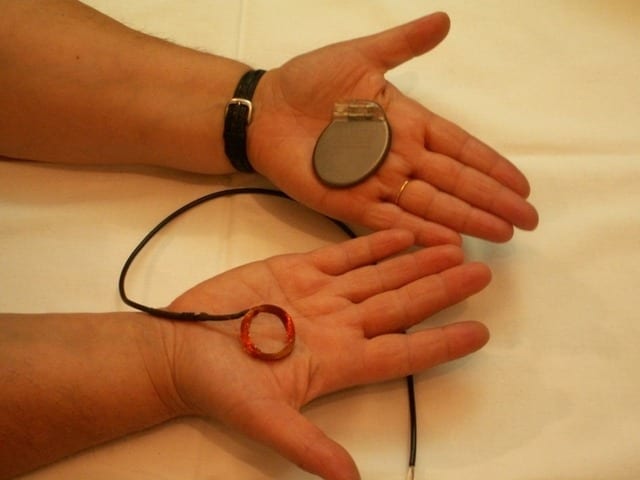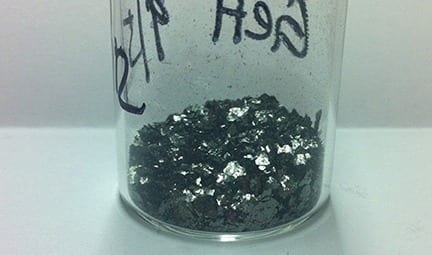
As a research project, the prototype has won a prize by “2005´s Jaime Filipe Engineer Award”
António Abreu, a Sustainable Energy Systems PhD Student under the MIT Portugal Program, currently developing research work at LNEG (Laboratório Nacional de Energia e Geologia I.P.) has developed a non-invasive battery recharger system for electronic implants that allows a longer life for the internal implantable devices in the human body such as, pacemakers, defibrillators, electric heart, delaying considerable the usual customary surgery intervention for replacement.
According to the world health organization, cardiovascular diseases are the leading cause of deaths. On a last resource, patients with cardiovascular disease have to be aided through surgery and medical devices to help them perform the basic functions. Nevertheless medical devices, such as pacemaker that sends electrical impulses to the heart muscle to maintain a suitable heart rate and rhythm, need a source of energy and once the battery has run out they required a surgical procedure similar to the initial implantation to replace the device.
With the non-invasive battery recharger for electronic cardiac implants the need for a new surgical intervention is reduced, since it primes from being rechargeable, i.e. the patient will not need to be operated upon to change batteries every five to seven years, since these are rechargeable by irradiant electricity passing through the body.
António Abreu adds that “The non-invasive battery also allows for a customize energy consumption of the cardiac implants, therefore the consumption of energy can be regulated to adapted to its function and patients’ pathology and activity. It guarantees the energetic supply of a communication channel between the exterior for diagnosis and/or implant reprogramming. In this case, there will be no demand of energy from the internal battery”.
The principle of the operation is the use of a high efficient Transcutaneous Power System. However, these typical systems use electronic converters witch generate hazard electromagnetic interferences (EMI) that causes damage to the implants as to the patients. The present innovation takes into account the Energy Efficiency in electric transmission systems without ferromagnetic cores, regarding medical application. In practice it eliminates the Gibbs phenomena.
The invention optimizes the energy flow determined by the regime of exploration previewed at the innovative Predictor-Corrector Abacus conception.
The Latest Bing News on:
Electronic implants
- ‘Can’t stop’: Man reveals reality of having Elon Musk’s Neuralink brain implanton May 18, 2024 at 4:43 pm
The first person to receive the Neuralink brain chip created by Elon Musk has spoken out about his experience with the implant.
- A 16-year-old took home $75,000 for her award-winning discovery that could help revolutionize biomedical implantson May 17, 2024 at 4:14 pm
Grace Sun won the ISEF science fair for her work on OECTs, which have benefits over current biomedical devices and could help a variety of diseases.
- Tiny electronic implant that wraps around spinal cord could help those with major injuries, University of Cambridge study suggestson May 16, 2024 at 11:30 pm
A tiny, flexible electronic implant that wraps around the spinal cord could lead to new ways to treat disability and paralysis-causing spinal injuries, research suggests. The devices have been ...
- Deaf community is divided over how cochlear implants affect deaf identity and cultureon May 8, 2024 at 2:08 pm
Cochlear implants have sparked controversy about deaf culture and identity for decades. Some say they treat deafness as a disability that needs to be fixed and undermine the use of American Sign ...
- Experimental device yields fresh hope for patients with spinal cord injurieson May 8, 2024 at 11:50 am
May 8 (UPI) --A combined science-medical team at Cambridge University in England has developed a new minimally invasive technique to treat spinal cord injuries with a miniature, wrap-around, ...
- ‘Wraparound’ implants represent new approach to treating spinal cord injurieson May 8, 2024 at 11:00 am
A tiny, flexible electronic device that wraps around the spinal cord could represent a new approach to the treatment of spinal injuries, which can cause profound disability and paralysis. A team of ...
- Tiny wraparound implants ‘represent new approach for spinal cord injuries’on May 7, 2024 at 5:00 pm
A tiny, flexible electronic implant that wraps around the spinal cord could offer new ways to treat disability and paralysis-causing spinal injuries, a new study suggests. The devices have been ...
- 'Wraparound' implants represent new approach to treating spinal cord injurieson May 7, 2024 at 5:00 pm
A tiny, flexible electronic device that wraps around the ... both piercing the spinal cord with electrodes and placing implants in the brain, which are both high-risk surgeries.
- Tiny implant that wraps around spinal cord could prevent need for brain surgeryon May 7, 2024 at 5:00 pm
A tiny, flexible electronic implant that wraps around the spinal cord could offer new ways to treat disability and paralysis-causing spinal injuries, a new study suggests. In the future ...
- Tiny wraparound implants ‘represent new approach for spinal cord injuries’on May 7, 2024 at 5:00 pm
A tiny, flexible electronic implant that wraps around the spinal cord could offer new ways to treat disability and paralysis-causing spinal injuries, a new study suggests. The devices have been ...
The Latest Google Headlines on:
Electronic implants
[google_news title=”” keyword=”electronic implants” num_posts=”10″ blurb_length=”0″ show_thumb=”left”] [/vc_column_text]The Latest Bing News on:
Battery recharger system
- How to Extend Laptop Battery Lifeon May 20, 2024 at 2:10 am
The short battery life of a laptop can be annoying for the user. Laptops have gained popularity mostly for their mobility. Users can take laptops outdoors or far from charging ports and do their tasks ...
- Axonics F15 Recharge-Free SNM Nabs Australian TGA Approvalon May 17, 2024 at 10:40 am
The F15 recharge-free sacral neuromodulation system is indicated for the treatment of adults with overactive bladder.
- Battery energy storage for microgridson May 17, 2024 at 6:35 am
A new battery energy storage system (BESS) engineered to be part of a flexible and scalable architecture, has recently been announced by Schneider Electric. The energy management and automation ...
- Ultra-high density battery vests give next-gen soldiers twice the energyon May 12, 2024 at 1:00 am
Amprius began shipping its remarkable silicone-anode batteries in 2022, laying claim to the world's highest-density battery cells along the way. It's now focusing attention on a unique use case: a ...
- Lithion Battery awarded contract with Navyon May 9, 2024 at 8:59 am
About Lithion Battery, Lithion is a vertically integrated manufacturer of cells and rechargeable and non-rechargeable battery ... are controlled by highly customizable battery management systems.
- SmallRig announce new high-performance rechargeable camera batteryon May 7, 2024 at 4:56 am
Repeat" is the aim of the game as SmallRig announces a powerful new rechargeable camera battery with a sleek new look. SmallRig manufactures some of the best camera peripherals on the market, from ...
- Battery chargers - what you need to knowon April 30, 2024 at 5:00 pm
Once you’ve worked out what type of battery charger you want, make sure you buy the best rechargeable batteries to put in it. The best AA rechargeable batteries last nearly eight hours on a single ...
- 2024 Volvo V60 Recharge Reviewon April 29, 2024 at 5:00 pm
The V60 Recharge features a Google-based infotainment system running Android Automotive OS built around ... It also features a 74-MPGe rating and offers 41 miles of electric-only driving on a full ...
- Implantable Battery Charges Itselfon April 24, 2024 at 6:37 pm
At smaller levels there have been some more outside-of-the-box developments for things like embedded systems and, at least in the case of this battery that can recharge itself, implantable ...
- The Best Battery Trimmers to Tidy Up Your Yard, Testedon April 24, 2024 at 3:00 am
We also tested the edger attachment, and the Quik-Lok system made it easy ... how much operating power the battery has, which is measured in volts. Today’s rechargeable string trimmer batteries ...
The Latest Google Headlines on:
Battery recharger system
[google_news title=”” keyword=”battery recharger system” num_posts=”10″ blurb_length=”0″ show_thumb=”left”]










